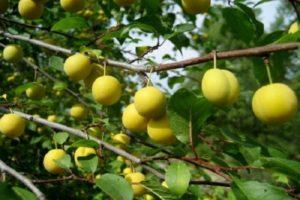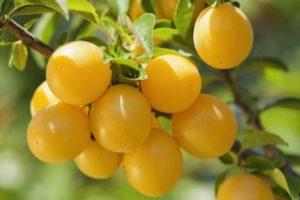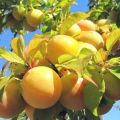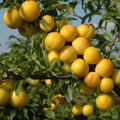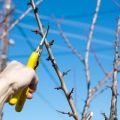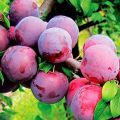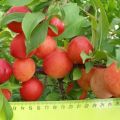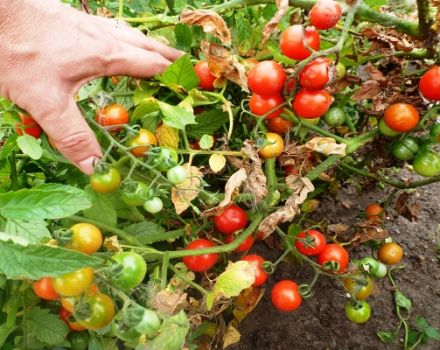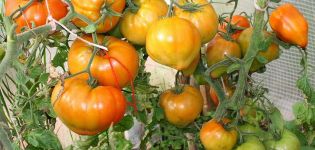Description of the plum variety President, growing and caring for the tree
The late-ripening plum President has won the recognition of gardeners due to its drought resistance, high productivity and transportability of fruits. This plant is actively grown not only in personal plots, but also on an industrial scale. The English variety is positioned as promising and reliable. In order for the President plum to bear fruit stably and abundantly, it is necessary to familiarize yourself with its strengths and weaknesses, the rules of planting and care.
External description of the tree
Plum President is characterized as a plant with an intensive growth rate and is not columnar. The tree develops a large number of annual lateral branches each year, which requires regular thinning.
Trunk height and crown size
Stone fruit culture reaches a height of 3.5-4 meters. The seedlings are distinguished by their ability to quickly adapt to new conditions; their annual growth is 40 centimeters. The crown of young plantings is outwardly similar to a pyramid, but over time it acquires a spherical shape. In the early years, the young growth is directed vertically upward, only after entering fruiting does it take a horizontal position.
The bark on the President plum is distinguished by a gray-green color, a smooth surface. Erect thick shoots are distinguished by a red-brown color, no pubescence. Lentils often located on the shoots are of medium size and white in color. The leaf plates are large, without pubescence, dark green in color and broadly rounded.

Inflorescences form 2-3 flowers. Their shape is pink, white, large in size. The fruits are found mainly on the bouquet branches.
Taste and type of fruit
Plum of the President variety is characterized as large-fruited, their average weight is 50 grams, but there are also specimens weighing 70 grams. The fruits are mainly one-dimensional, their shape is round, the skin is moderately dense, there is a waxy coating. The color of the plum, as it ripens, changes from green to blue with a shade of purple. The flesh is moderately firm, the color is predominantly yellow.
The consumer and commercial qualities of the President plum are at a high level. Delicate and sweet pulp has a slight acidity. The seed of the variety is separated without much difficulty. Fruit juice is transparent. Plum tasting score President of 5 points 4.5.
The sugar content of the variety is 8.5%, acidity 2.46%, and dry matter 15.5%. The content of ascorbic acid in plums of the President variety per 100 grams is 6.12 milligrams.
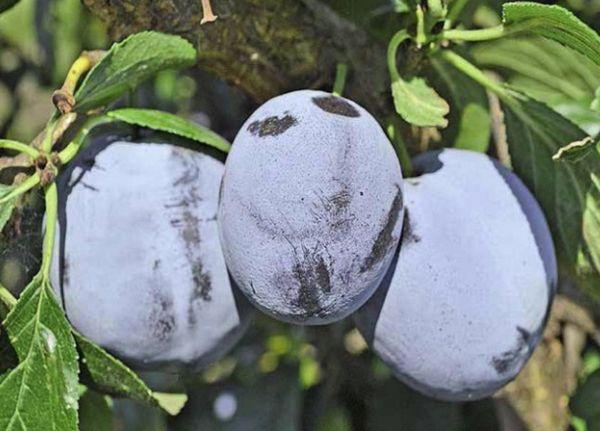
Pros and cons of culture
Experienced gardeners note among the positive characteristics of the President variety:
- large-fruited;
- excellent taste of fruits;
- excellent presentation;
- a sufficient degree of frost resistance;
- the harvested crop is not afraid of long-distance transportation;
- unpretentiousness to growing conditions;
- endurance to adverse environmental factors;
- self-fertility;
- high and stable yield.
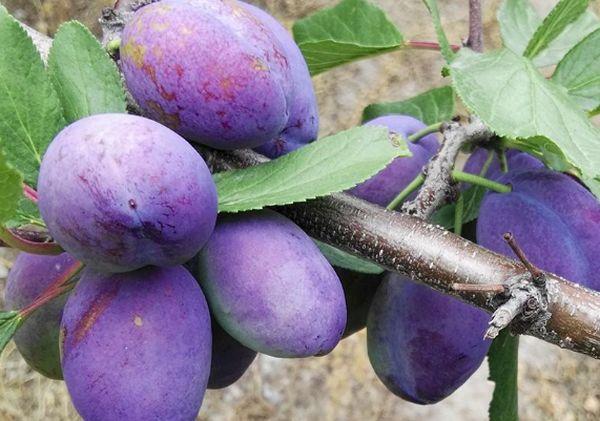
But the President plum also has its drawbacks:
- the need for annual formation;
- tendency to gum flow;
- requires the installation of additional supports for fruiting branches;
- low level of resistance to plum moth, small aphids, moniliosis.
Variety characteristics
Plum President is very popular among gardeners, reviews about it are mostly positive.
Climate and regions of growth
This fruit variety, due to its ability to quickly adapt to new conditions, can be actively cultivated in Siberia, the Urals, and Ukraine and Moldova.

Susceptibility to disease and insects
If you follow all the recommendations regarding the cultivation of fruit crops, then the risk of developing dangerous ailments and the invasion of harmful insects is minimized. Plum President is susceptible to diseases such as:
- Clasterosporium disease. Hole spotting appears as brown foci not only on fruits, but also on leaves. The affected parts of the tree begin to dry out after a while. Processing is carried out with copper oxychloride or 1% Bordeaux liquid.
- Fruit and gray rot. The disease is determined by the ugly gray growths on the leaf plates of the plant, fruits. There is also a white or gray coating. The President uses Bordeaux liquid 1%, Hom, against rot on the drain.
- Moniliosis. The disease is detected by the presence of white bloom on the fruits, drying out and falling leaves. Horus is used against him.
- Gum therapy. Bark beetles are the source of the problem. Plants are treated with 1% copper solution.
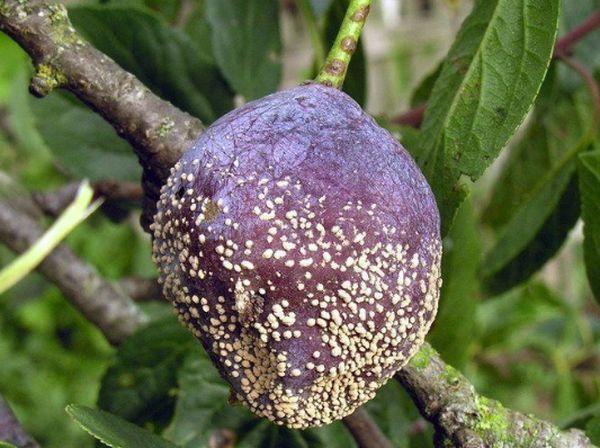
Among the parasitic individuals that are often found on the President's plum, they note:
- lacewing (drug Karbofos);
- aphids (soap-ash solution);
- moth (Karbofos).
Resistant to freezing temperatures and droughts
Plum of the President variety is positioned as a plant with a high level of frost resistance and drought resistance. Fruit crops are not afraid of dry weather and cold weather.
Pollinating varieties
For effective pollination of the President plum, such plants as Skorospelka red, Mirnaya, Renklod Altan, Ternosliv Kuibyshevskaya are needed. It has a positive effect on the variety by placing it near Amersom, Joyo, Herman, Renklode Temples, Rush Geshtetter, as well as the Rival, Kabardian early.
Flowering and ripening period
The flowering phase of the President plum falls in mid-May. Harvesting a large harvest is possible only in the second half of September. If the summer was not too favorable, then the fruits will ripen only by the end of September.
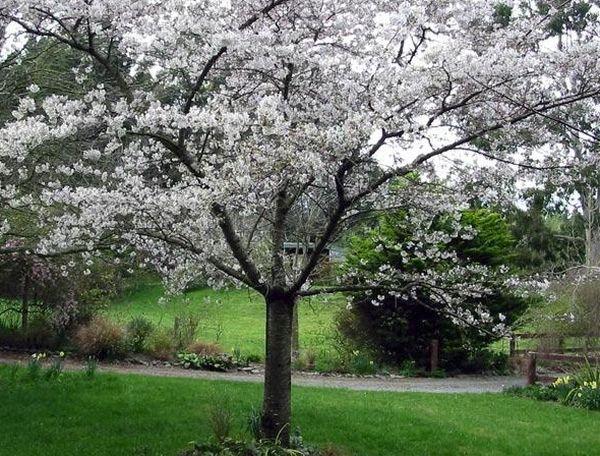
Productivity from one tree
The plant begins to bear fruit only in the fifth year after planting in a permanent place. From a tree that is up to 10 years old, the yield is almost 17 kilograms, then 20-40 kilograms. With favorable growing conditions and proper care, almost 70 kilograms can be removed from one tree.
Transportability and use of the fruit
Plum President is distinguished by good keeping quality of fruits that are not afraid of long-distance transportation and retain their presentation for a long time. The purpose of the harvest is universal, it is used for winter preparations, and for preparing compotes, desserts, and also consumed fresh.
How to grow a plum on the site
A competently executed plum planting by the President increases the chances of harvesting a bountiful harvest.
Disembarkation dates
Seedlings can be planted both in autumn (October-end of September) and in spring (March-April). But it is best when planting works are carried out in spring at an air temperature of 12 degrees.
Optimal location
In order for the ripened fruits to be sweet enough, it is necessary to place the President plum in a well-lit clearing protected from through winds. Landing in swampy areas and in places with a close occurrence of groundwater (up to 1.5 meters) is not permissible.
Recommended and contraindicated neighbors
Only the apple tree gets along well with the President's plum. Other fruit trees are not suitable as neighbors for this variety. Of the berry bushes, black currant is the best option; raspberries and gooseberries are also acceptable.
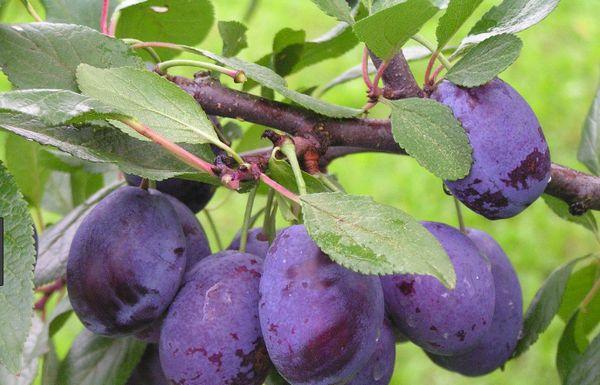
Preparation of planting material
It is recommended to purchase seedlings in the fall, when the leaves are absent, the bark can be best seen. It should not show signs of damage, signs of disease, rot. It is advisable to buy planting material in specialized retail outlets, nursery. Such specimens have already been adapted for specific conditions and can quickly take root in a new place.
To avoid freezing of the root system of the plum, the President should not transport it at temperatures below 6 degrees.
Landing technology
To create comfortable conditions for the growth and development of the President plum, it is necessary:
- Prepare a hole 50-60 centimeters deep and 80 centimeters wide.
- Departing from the center 15-20 centimeters, install a wooden peg. Its height above ground level should be 70-80 centimeters. Such support will allow you to reliably hold the young plant until it gets stronger.
- Fill the hole with fertile soil mixture. It consists of the soil extracted during the digging of the hole, organic fertilizer (20 kilograms), superphosphate (500 grams).
- Place the seedling, spread its roots and sprinkle with soil.
- Fix the plant to a support.
- Pour water over the President's plum (30-40 liters per planting).
At the end of planting work, it is recommended to mulch the near-trunk circle with rotted sawdust, grass.
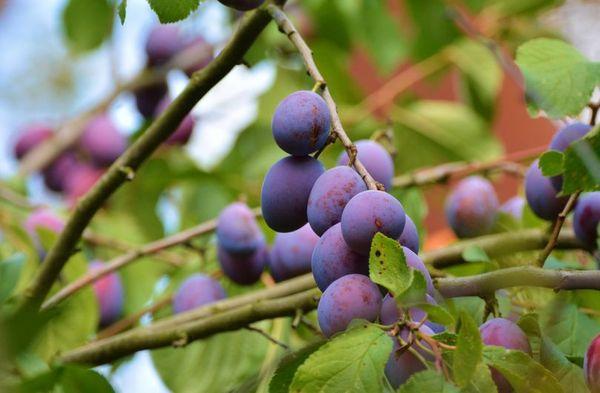
How to care for a tree
Plum care President consists of timely moistening, loosening the soil, removing weeds, and feeding procedures.
Irrigation and fertilization
Despite the fact that the President's plum copes well with dry weather and lack of moisture, a large harvest is possible only if the norms and frequency of irrigation measures are observed. By means of a drip irrigation system, the procedure is carried out once every 2 weeks. Consumption per garden planting in the first half of the summer season is 4 buckets of water, and in the second - 2 buckets.
In spring, young plants must be fed with a mixture of urea (20 grams) and ammonium nitrate (20 grams). For adult plantations, whose age is from 5 years old, a nutrient composition of compost (1 bucket), simple superphosphate (60 grams), urea (25 grams) and potassium chloride (20 grams) is needed. After harvesting, a top dressing of superphosphate (70 grams), wood ash (300 grams) and potassium salt (30 grams) is added to the soil. The amount of nutrients is calculated for processing 1 square meter.
Barrel circle care
In order to prevent oxygen starvation of the President plum roots, the soil in the trunk circle must be loosened after each irrigation and rain.

If there are weeds, they must be removed, otherwise they will only take on not only useful components, but also moisture. The best option is to mulch the land around the President plum with sawdust and peat.
Formation
Presidential formative pruning is performed in the first three years after planting. Branches and side shoots are shortened by 20 centimeters. Thanks to regular pruning, as early as the fourth year, the fruit tree will have a two-tiered structure consisting of 6 main branches. With the right approach, the side branches of the President drain will be at a 45 degree angle.
Preparing for winter: rodent protection and whitewashing
An invasion of rodents is a serious threat to the President's plum, especially the skeletal branches located in the lower tier, the stem, the underground part of the plant suffer from them. There are several effective ways to protect the President's plum:
- whitewash the fruit crop;
- install a metal mesh around the perimeter of the garden;
- treat the trunk of the President plum with a mixture of lard and tar;
- scatter peat chips soaked in kerosene over the area;
- wrap the plum trunk with glass wool or spruce branches;
- tie the stem of the plant with synthetic stockings.
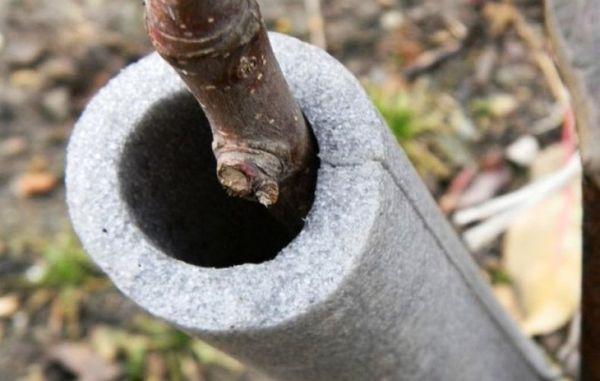
In the spring, when the weather is warm, the additional protection should be removed from the trees.
The President should be engaged in whitewashing plums before the onset of frost - in late autumn. Not only the plum stem is processed, but also its skeletal branches. This technique allows you to disinfect the bark, destroy pathogenic microorganisms and eggs of parasitic individuals. In addition, due to the bitter taste, such plants cease to be prey for rodents, the trees increase their immunity and the level of endurance to adverse environmental factors.
For these purposes, it is effective to use water-based or aniline paint, it is consumed at the rate of 0.7-1 liters per one garden planting. The effect of such whitewashing lasts for one year. Another option for whitewashing the President plum consists of: lime (2-3 kilograms), copper sulfate (300 grams), clay (1 kilogram) and 10 liters of water. It is recommended to use chalk for processing young plants.
Plum variety President, by right, belongs to promising plants. It is unpretentious, high-yielding and cold-resistant. The main thing is to adhere to the correct agricultural techniques, and the result will not be long in coming.
